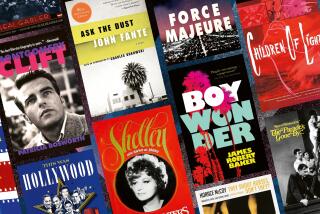TV REVIEW : Intelligent Sketch of the Man Who Made the Movies
D. W. Griffith is one of the greatest of all film artists and yet his work has been largely relegated to the film history books.
A new “American Masters” documentary, “D.W. Griffith: Father of Film” (airing from 8-11 tonight on KCET-TV Channel 28), attempts to redress the neglect.
Filmmakers Kevin Brownlow and David Gill, who previously produced the extraordinary “American Masters” segments on Charlie Chaplin, Buster Keaton and Harold Lloyd, don’t quite make it four in a row--perhaps because Griffith is a more difficult case than those others. He gave very little of himself away in public; his official posture was almost regal. In private, he was probably a mystery even to himself. His movies--both the epics such as “The Birth of a Nation” and “Intolerance” and the small-scale masterpieces such as “Broken Blossoms”--don’t benefit from being excerpted; their sweep and mood require the full-length treatment. (And a big screen.)
What Brownlow and Gill do superbly well is give a sense of what odds Griffith was working against. Raised in the South with no formal education, Griffith knocked about the country in touring theatrical companies for 10 years before finally condescending to work in the fledgling film industry. The Victorian bombast and sentimentalities that were the lifeblood of his theatrical experience all went into his movies.
But at the same time, starting with his first short film in 1908, Griffith was laying the grammar and the groundwork for the great art form of the 20th Century. The collision between his Victorian sensibility and the growing sophistication of his technique accounted for both his greatness and his eventual decline: He entered the Jazz Age humming the wrong tune.
Brownlow and Gill intersperse clips from Griffith’s films with interviews with his many co-workers, including Lillian Gish, Anita Loos, cinematographer Karl Brown and with his second wife, Evelyn Baldwin Kunze.
Some of this footage is more than a decade old and derives from the team’s research for their 13-part silent-film series “Hollywood.” Few of Griffith’s colleagues are still alive, so this parade of talking heads has a poignancy; these people who have now passed from sight were the only living witnesses to the birth of film.
Griffith’s innovations are sometimes sketched for us in quick, deft strokes. We see, for example, how he developed the close-up, as Brownlow and Gill compare a similar scene from two short gangster films made a year apart. We see some of the paintings that influenced the tableaux of films such as “The Birth of a Nation” and “America.” There is some rare, amazing footage of Griffith as an actor, of Griffith directing his actors and, late in life and embittered, of him rehearsing to accept an award from the Academy of Motion Picture Arts and Sciences. The clips from his films are projected at the proper speed (not always the case with silent films on television) and often beautifully tinted and backed by the original musical scores. Extraordinary care has been taken with Griffith’s legacy.
The controversy surrounding the racism in “The Birth of a Nation” (1915), which was instrumental in reviving the Ku Klux Klan, is dealt with at some length. The comments of historian John Hope Franklin and actor William Walker, both of whom are black, are pertinent to the social destructiveness of the film.
The greatness of “The Birth of a Nation” has always been problematic; it goes to the heart of the question about whether there is such a thing as immoral art. Brownlow and Gill don’t delve deeply into the quandary but their point seems to be that Griffith, raised in Kentucky with tales of the glory days of the Confederacy, was unconscious in his racism.
His next film, “Intolerance,” a reaction to the outcry over “Birth of a Nation,” was meant as a grand-scale plea for understanding. It was, of course, immeasurably richer than that. For most film historians, “Intolerance” is one of the art form’s crown jewels.
The documentary would have benefited from the participation of a film critic to balance the other voices. (James Agee’s unmatched 1947 essay on Griffith should be distributed to PBS subscribers.) It also skimps the opportunity to show us some of Griffith’s more unremarked great sequences.
But the famous ice floe rescue from “Way Down East” is on view, and so is that magical moment in “Orphans of the Storm” when the Gish sisters are reunited.
Brownlow and Gill must have recognized going into this project that Griffith was an Everest of a subject. They’ve scaled high, not dizzyingly so, but with enough height to intelligently survey one of the great cultural figures in American history.
More to Read
The complete guide to home viewing
Get Screen Gab for everything about the TV shows and streaming movies everyone’s talking about.
You may occasionally receive promotional content from the Los Angeles Times.






